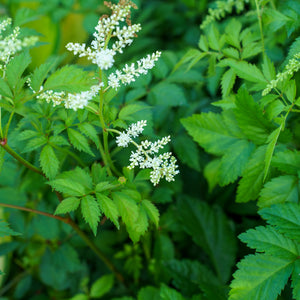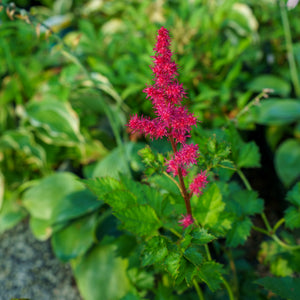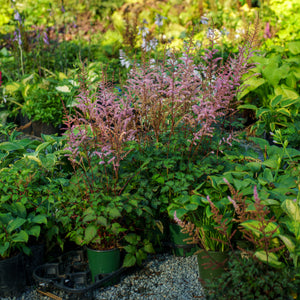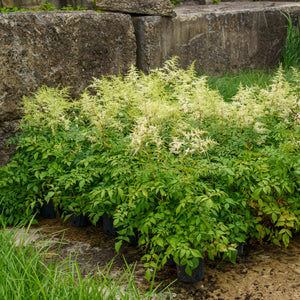The Astilbe Guide
Astilbe, known for its feathery plumes and lush foliage, brings a touch of elegance and vibrant color to shaded garden areas. These hardy perennials are perfect for adding texture and beauty to borders, woodland gardens, and shaded beds. With blooms that range in color from soft pinks and whites to deep reds and purples, astilbe plants are a favorite among gardeners looking to brighten up their shady spots. Whether you aim to create a serene shade garden or add dynamic layers to your landscape, astilbe offers a reliable and enchanting solution. With minimal maintenance requirements and adaptability to various soil types, astilbe is a hassle-free addition to any garden. Explore our Astilbe Guide to learn more about cultivating and caring for these delightful perennials, and discover how to incorporate them into your garden for lasting beauty and enjoyment.

About
Astilbe, a member of the Saxifragaceae family, is prized for its delicate, feathery plumes of flowers and attractive fern-like foliage. Native to Asia and North America, astilbe thrives in moist, shaded environments, making it an excellent choice for woodland gardens and shaded borders. The genus Astilbe includes several species and numerous cultivars, each offering unique characteristics and a range of flower colors.
Astilbe plants typically bloom from late spring to early summer, with some varieties extending into late summer. The flowers, which can range from soft pastels to vibrant hues, rise above the foliage on tall, slender stems, creating a striking vertical accent in the garden. In addition to their ornamental value, astilbe flowers are attractive to pollinators such as bees and butterflies.
Astilbe's foliage remains attractive throughout the growing season, providing texture and color even after the flowers have faded. The leaves are typically deep green, though some varieties offer bronze or reddish tones, adding further interest to the garden.
Astilbe is relatively low-maintenance and disease-resistant, making it a favorite among gardeners seeking beautiful, dependable plants for shaded areas. They are also deer-resistant, adding to their appeal in gardens where deer are a problem.
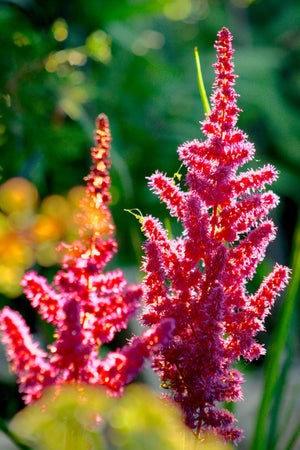
Planting
Astilbe plants require specific planting conditions to ensure their successful establishment and flourishing growth. Here are some essential guidelines for planting and caring for astilbe:
Soil: Astilbe thrives in rich, well-drained soil with a pH level ranging from 6.0 to 7.0. Prepare the planting site by loosening the soil and incorporating organic matter such as compost or well-rotted manure to improve soil structure and fertility. Good drainage is crucial, as astilbe does not tolerate waterlogged conditions.
Sunlight: Astilbe prefers partial to full shade. While some varieties can tolerate morning sun, they generally perform best in locations with filtered sunlight or dappled shade. Too much direct sunlight can scorch the foliage and reduce flowering.
Watering: Adequate watering is essential, especially during the initial growth stages. After planting, water the astilbe deeply to establish strong roots. Maintain consistent soil moisture, particularly during dry periods, as astilbe prefers evenly moist conditions. Mulching can help retain soil moisture.
Mulching: Apply a layer of organic mulch around the base of your astilbe plants to retain moisture, suppress weed growth, and regulate soil temperature. Use materials like wood chips, bark, or compost, ensuring the mulch is kept a few inches away from the plant stems to prevent moisture-related issues.
Spacing: Plant astilbe 12 to 24 inches apart, depending on the variety and their mature size. Proper spacing ensures adequate air circulation and reduces the risk of fungal diseases, promoting healthy plant development.
Planting Time: The best time to plant astilbe is in the spring or early fall when temperatures are moderate. This allows the plants to establish strong root systems before the onset of extreme weather conditions.
Depth: When planting astilbe, ensure the top of the root ball is level with the soil surface. Planting too deeply can hinder growth and lead to root rot.
By following these planting and care instructions, you can ensure the successful establishment and thriving growth of your astilbe plants. With proper attention, astilbe will bring vibrant color and delightful blooms to your garden, enhancing its charm and appeal for years to come.
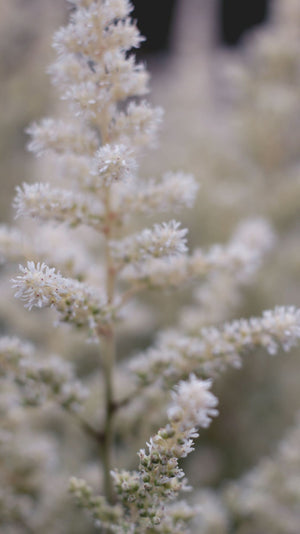
Care
Astilbe plants require specific care to ensure their optimal growth and health. Here are some general guidelines for the care of astilbe:
Watering: During the growing season, provide regular watering to your astilbe plants. Aim to keep the soil consistently moist but not waterlogged. Water deeply at the base of the plant to encourage deep root growth and to prevent fungal diseases. Astilbe prefers evenly moist conditions, so adjust watering frequency based on rainfall and weather conditions.
Pruning: Pruning is essential for maintaining the shape and vigor of astilbe plants. Remove spent flower plumes to encourage new growth and prevent self-seeding. In late fall, after the first frost, cut back the stems to about 1-2 inches above the ground to prepare the plants for winter.
Fertilizing: Fertilizing can help boost the growth and blooming of astilbe plants. Apply a balanced, slow-release fertilizer in early spring when new growth begins and again in mid-summer. Follow the recommended dosage on the product label and avoid over-fertilizing, as this can lead to excessive foliage growth at the expense of flowers.
Soil and Sunlight: Ensure that astilbe is planted in rich, well-drained soil with a pH level ranging from 6.0 to 7.0. Astilbe thrives in partial to full shade, with filtered sunlight or dappled shade being ideal. Amend heavy clay soils with organic matter to improve drainage.
Mulching: Apply a layer of organic mulch around the base of your astilbe plants to retain moisture, suppress weed growth, and regulate soil temperature. Use materials like wood chips, bark, or compost, ensuring the mulch does not touch the plant stems directly to prevent rot and fungal issues.
Pests and Diseases: Astilbe is generally resistant to pests and diseases, but it can occasionally encounter issues such as powdery mildew or root rot. Inspect your plants regularly and treat any infestations promptly with appropriate organic or chemical controls.
Dividing: Astilbe benefits from occasional division to maintain vigor and prevent overcrowding. Divide the plants every 3-4 years in early spring or late summer. Dig up the clump, separate it into smaller sections with healthy roots and shoots, and replant them at the same depth as the original plant.
Winter Care: In colder climates, protect your astilbe plants from harsh winter conditions by applying a layer of mulch to insulate the roots. Remove any debris from around the plants in the fall to reduce the risk of pests and diseases overwintering in the garden.
By following these care guidelines, your astilbe plants will thrive and add vibrant color and delightful blooms to your garden for years to come. With their resilience, low maintenance requirements, and stunning flowers, astilbe is a valuable addition to any landscape, providing year-round interest and charm.

How To Use
Astilbe offers versatility and can be utilized in various ways to enhance your landscape. Here are some recommendations based on their characteristics:
Shade Gardens: Astilbe is perfect for brightening up shaded areas of your garden. Plant them under trees or in woodland gardens to add color and texture where other plants may struggle.
Borders and Edging: Use astilbe to create beautiful borders and edges along pathways, garden beds, or driveways. Their tall, feathery plumes add a soft, elegant touch to garden designs.
Pollinator Gardens: Astilbe flowers attract pollinators like bees and butterflies. Plant them alongside other pollinator-friendly plants to create a thriving ecosystem that supports local wildlife.
Mixed Perennial Beds: Incorporate astilbe into mixed perennial beds for continuous seasonal interest. Pair them with other shade-loving plants like hostas, ferns, and heucheras to create a lush, layered look.
Containers: Astilbe can be grown in containers, making them perfect for patios, balconies, or entryways. Plant them in pots or mixed containers to enjoy their beauty up close. Ensure the containers have good drainage to prevent waterlogging.
Cottage Gardens: Astilbe fits perfectly into cottage garden designs, where their informal, natural look blends well with other traditional garden plants. Combine them with roses, foxgloves, and delphiniums for a charming, old-fashioned garden.
Cut Flower Arrangements: Astilbe blooms make excellent additions to cut flower arrangements. Harvest the flowers when they are fully open and use them in bouquets, centerpieces, or floral displays to bring their beauty indoors.
Ground Cover: Use low-growing astilbe varieties as ground cover in shaded areas. Their dense foliage helps suppress weeds and provides a carpet of vibrant blooms in late spring and early summer.
When incorporating astilbe into your landscape, consider their growth habits, sunlight requirements, and soil preferences. By choosing the right placement and utilizing their versatile nature, astilbe plants can enhance the beauty and functionality of your outdoor space, providing year-round interest and vibrant blooms.
Conclusion
Astilbe is a versatile and enchanting addition to any garden landscape. With its feathery plumes, lush foliage, and adaptability to shaded environments, astilbe brings a touch of elegance and vibrant color to your outdoor space. Their ease of care and resilience make them a favorite among gardeners of all levels. By following proper planting and maintenance techniques, you can fully harness the potential of astilbe to elevate your garden and create a lasting impact.
Whether you seek to create serene shade gardens, brighten up borders, or enhance mixed perennial beds, astilbe can fulfill a variety of roles in your landscape design. Plant them individually to highlight their unique beauty, or cluster them together for a dramatic visual display. Astilbe's ability to thrive in various soil types, attract pollinators, and provide stunning cut flowers adds to their appeal, making them a valuable addition to any garden.
Beyond their ornamental value, astilbe contributes to the overall health and beauty of your garden ecosystem by attracting beneficial insects and providing habitat for pollinators. Their low maintenance requirements and long blooming period make them an excellent choice for sustainable gardening. With their enduring beauty, versatility, and ecological benefits, astilbe plants bring natural allure and vibrant charm to your outdoor environment, enriching your gardening experience and enhancing the overall beauty of your landscape.




